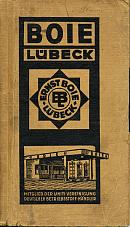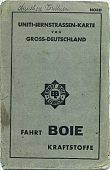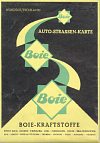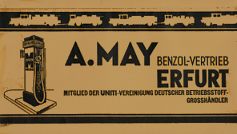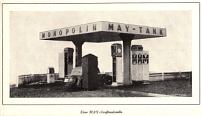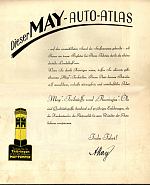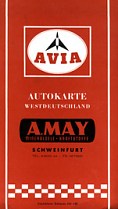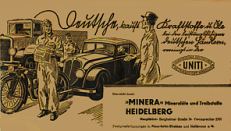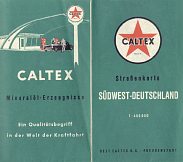AVIA Participants from Germany
Boie, May, Minera and Oest
Brief History
Although AVIA maps can be found from several countries, except in Germany most AVIA participants were not large enough to have issued their own maps prior to joining the co-operative association. The German situation was rather different, as many of the names that formed AVIA were (and remained) part of the UNITI trade association which arranged for maps bearing the names of most of its members.
This page will concentrate on maps from Boie, A. May, Minera and Oest, all of which remain active members of the AVIA organisation in Germany (or in the case of May, was active until its bankruptcy in 2000). A 1950s Avia map overprinted for Zeller+Gmelin is shown on the page alongside its Divinol brand.
Maps: Boie
Ernst Boie of Lübeck was established in 1876 and entered the fuel business around 1898, before opening its first filling station in 1925. Around 1974 Boie switched from its own green, yellow and black brand to AVIA under the slogan "Pardner in Europa". Boie continues to exist as an AVIA participant to this day, with 9 depots in Northern Germany.
|
|
The left hand Uniti-Boie paper covered atlas dates from around 1937 and has 13 thumb-indexed pages of full colour maps, with towns with Uniti-group filling stations marked. The rear of each map page includes black and white city plans, a complete listing of the 135 Boie stations and advertising for Boie and its Erbojol motor oil. Cartography was by Dr. Güntzsche Stiftung, Dresden to a scale of 1:1,000,000. |
|
|
|
In the early or mid 1950s, Boie issued a small format map of Northern Germany (left), primarily as a location map for its filling stations. When unfolded it measures just 270x490mm, and shows Germany as far South as Hannover using a Falk map at 1:650,000. This also marks towns and villages with Boie filling stations. On the reverse they are fully listed; despite losing a number of sites in East Germany, the chain had grown to around 158 locations, including 34 in Lübeck alone. |
|
|
By 1959 (above right) Boie had slightly expanded the format of the map, although they still used Falk cartography, printed in Hamburg by Carl Griese. The map was now at 1:500,000 - with insets of the West Harz area and the island of Fehmarn at 1:250,000 - and highlights all towns or villages with Boie stations in yellow. The area covered extended further South to allow stations supplied from its new Braunschweig depot to be included on the map, but the address listing had been dropped. The map refers to the introduction of Boie's new 100 Octane Super-Benzin in Spring 1959, and uses a consciously more modern style of writing for the company logo. |
||
Maps: May
A May Benzol-Vertrieb was established in Erfurt in 1896, and built up a chain of black and gold filling stations before the war. As Erfurt was in East Germany, the family owners established a new base in Schweinfurt in 1950, a couple of years before the old Eastern operations were expropriated. In 1953 they became an early German participant in AVIA - see the AVIA page for an example of a fairly early Avia map overprinted with A May's name. A May were one of the first independents to move back into Eastern Germany, re-opening in Erfurt in 1990, but continuing losses in the new states (and a price war in the West) led to the company filing for bankruptcy in September 2000 and the company has since ceased trading. Many of its service stations passed to other AVIA members, including Minera, in early 2001.
|
|
|
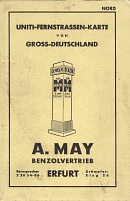
|
| A May atlas (images courtesy of Jon Roma): top left - front cover; lower left - photograph inside; above - letter from May to users. Above right - 1939 map cover |
||
|
The three images (above left and centre) are taken from a pre-war atlas, similar to the Boie and Minera examples. The atlas lists 119 locations where May's products can be bought; they included a benzol/gasoline mix "Thurinol", a "special" gasoline "Thurin", the gasoline/alcohol mix "Monopolin" and "Thuringia" lubricants. |
|
Maps: Minera
Minera was established in the early 1920s at Heidelberg and soon became a member of UNITI. Unlike the other firms on this page, Minera continued to use its own brand until the mid-1960s, although a contemportary photograph suggests that some stations may have been wholly unbranded. By 1975 it had switched to the AVIA identity and moved its offices to Mannheim. The company later became Minera Rempel KG and currently operates over 75 AVIA stations, in addition to 10 under the BFT co-operative brand.
|
|
The 1930s map-atlas shown left uses a common cover design selected by most of the smaller Uniti members. Inside there are 13 pages of maps by Dr. Güntzsche Stiftung. |
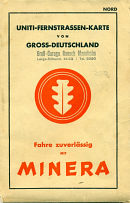 |
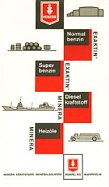 |
Just before the War, Uniti moved to a simpler sheet map format in grey or tan covers. The version for Minera is unusual in that the company details were overprinted in red, not just black. (The grey text under the title is a dealer service station stamp.) Internally, as well as a map at the slightly reduced scale of 1:1,100,000, there was an advertising panel showing a car in front of a Minera zapfstelle (single large fuel pump).
The 1965 map (above right) shows the same Minera logotype as the map from 25 years earlier and advertises their "Exaktin" grades of petrol. This map of Southern Germany was prepared for them by JRO-Verlag of München at a scale of 1:750,000; it's possible that they would not have also produced a Northern Germany map as that was outside their marketing area.
Maps: Oest (Östol)
Georg Oest & Cie were established around 1930 in Freudenstadt, SW Germany, and built up a chain of filling stations under the Östol name. In the mid-1950s, when the AVIA co-operative first allowed non-Swiss companies to join, Oest were one of the first German brands to switch to the new colours. However, within a decade Oest had signed up to be a jobber for Caltex, as that company was a late entrant into the German market and was looking to expand. By 1968, when Caltex was split by its owners into Chevron and Texaco, Oest supplied around a quarter of the network. Surprisingly, Oest chose to go it alone and continued to use the Caltex name on its 350 service stations for around four more years - the only remaining Caltex sites in Europe. During 1973, possibly as a result of the previous year's oil supply problems, Oest rejoined AVIA, and continues to be one of the largest German participants today. Oest has always been strong in lubricants and greases, and the Oest name is still used on motor oil and similar products.
|
Oest relied on JRO-Verlag of München to provide them with a map of SW Germany, even when it did not fit into the corporate map programme of their supplier. Left is a mid-1950s issue in AVIA colours, printed soon after they had switched away from their Östol brand. A decade later they had become Oest Caltex KG, when they issued this similar JRO map in their new company colours. |
|
Among other current AVIA participants, Kurt Isermeyer can trace its origins to Oelvertrieb Nordhausen, for which a map is shown on the UNITI page. Otto Fricke only switched to the AVIA brand in 2002, but had for over 50 years distributed DEA branded fuel and there is a DEA map centred on its base of Gutersloh believed to have been prepared specially for the company.
Please follow this link the page for other UNITI members that did not, as far as is known, switch to AVIA colours.
Text and layout © Ian Byrne, 1999-2013
All original copyrights in logos and map extracts and images are acknowledged and images are included on this site for identification purposes only.

